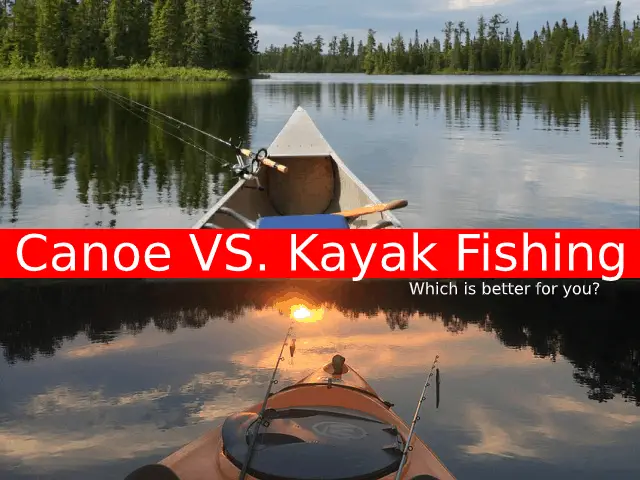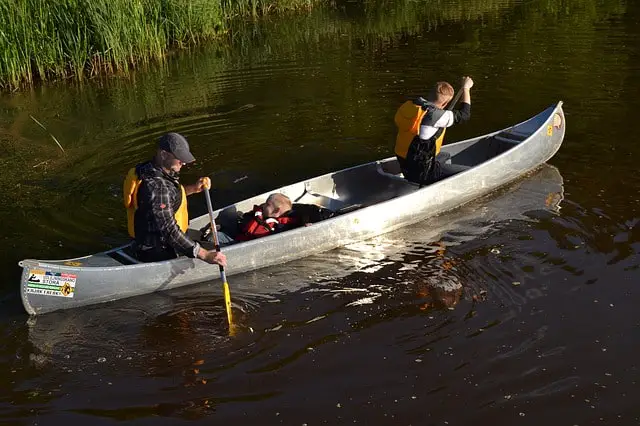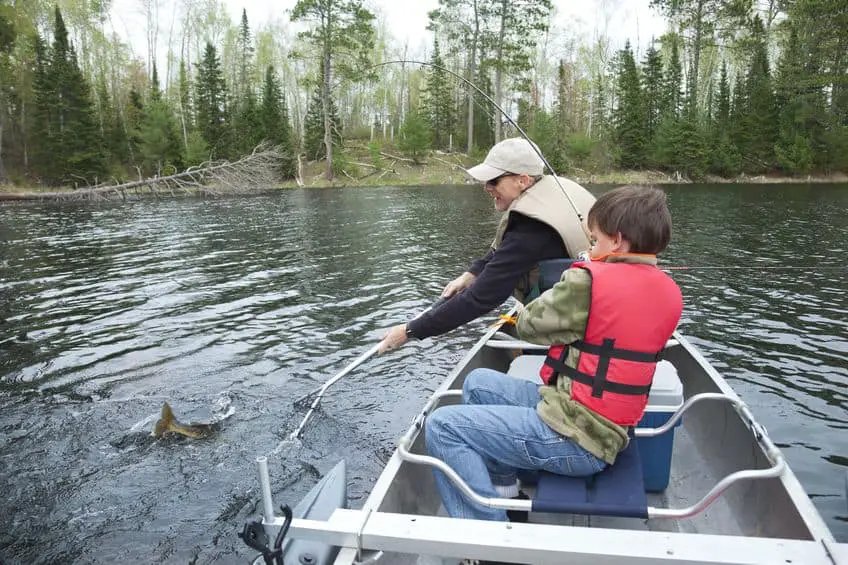
This age-old debate that can literally be traced back thousands of years when the two sports began: Canoe fishing or Kayak fishing? The question creates heated controversy, truly passionate opinions, and a divide on the equipment-front for the die-hard defenders that lie on each side of the proverbial boat. So, which is truly better?
In the Canoe vs. Kayak Fishing debate, there is no correct answer as it’s a subjective matter which varies from person to person. Each type of fishing has its own pros and cons, but essentially the argument comes down to
| Canoes | Kayaks |
| Larger | Smaller |
| Heavier | Lighter |
| Easy to Port | Cannot be Ported |
| Better for Multiple People | Better for Solo Riders and Rough Waters |
We will cover the pros and cons of each so you can make the best decision for your fishing experience. By the end of this quick read, you’ll be a more knowledgeable fisherman (or fisherwoman!) and know how to get the easiest fishing experience possible for your intentions and needs. One may not be better than the other, but we’ll get to the bottom of which is the best for you!
Canoe vs Kayak Fishing

Fishing has long been considered one of the best forms of rejuvenation and one of the most peaceful sports. It feels good on a somewhat primal level to catch our own food. Not only that but to do it in the center of nature, surrounded by the serene mornings with birds chirping, and the utter suspense of the hunt!
Did you know that it can be difficult to research the differences between the two variations because people often group them together, not realizing or acknowledging their differences?
Even in the Olympics, both canoeing and kayaking are grouped under the same sporting event – canoeing. Let’s begin by being clear – they are completely different boats.
The main difference people notice right off the bat between a canoe, and a kayak is their physical appearance.
They are similar vessels yet have tangible differences that cannot be ignored. Essentially, the canoe is like a soccer mom’s van (practical, all-purpose, and useful), while the kayak will be like dad’s red shiny sports car (zippier, lighter and more compact, better for speed and a variety of other sports).
The size and structure vary between each model, but the main differences are:
Canoes:
- Are larger
- Hold more people
- Good for carrying supplies/gear
Kayaks:
- Are smaller
- Often inflatable
- Easiest to transport
There is no wrong answer, only which will be most beneficial to your fishing experience and which vessel you find the easiest to maneuver. You may need to practice with each to gain a feel for your own paddling technique and what feels most natural.
The factors which may influence your decision and what you should be considering while you read this article are:
- What is my intended use for it? (quiet lake, vicious rapids, etc).
- What kind of comfort or seating do I need?
- What storage options are available to me?
- What is more practical for my needs?
These will help you to have a direction to point your compass in before we begin. I love to explore each side of the argument and where the variations lie. So, let’s explore some of the major pros and cons of each fishing vessel, perhaps understanding by the end of it what all the millennia-long fuss is about.
A Canoe Discussion

Larger doesn’t always mean better. This is the argument Kayak lovers bring to the table when arguing the dramatic debate between the two vessels. It may or may not surprise you how emotionally attached and invested people can get to their tribe.
In the case of the canoe family, their love runs deep for the more traditional fisherman’s quality that they feel can only be embodied through the canoe. It has a more nostalgic and rustic feel to it, as compared to an inflatable, sleek kayak.
If you’re the traditional type, you may love canoes for this reason alone and stand by it as a means of principle. You’re not alone in this fandom with tens of millions of registered boaters enjoying their time on the water each year.
Canoes actually date back to ancient times as the first types of boats which were ever used.
Canoes are often created from a large piece of wood with logs that are hollowed out. The anglers have advanced significantly in the modern world, and they are quite sleekly designed, especially compared to the ancient standard.
The arguments for why a canoe is superior to the kayak are as follows:
- They’re Bigger – to play devil’s advocate to my leading statement in this section, many believe that bigger is in fact better. I think this goes on a case by case basis but have to agree with the ease of having more space in the boat for people, gear, tools and supplies, and the most important thing, snacks.
A kayak may look sexier and move faster, but perhaps you’re there to take your time. You want to sit slowly as to not scare the fish away as a proper fisherman ought to. There’s really no arguing that this logic is wrong, it’s really just about which you prefer.
Be careful standing in a canoe because it has a lower center of gravity and you risk falling in.
- They’re Durable – Another valid point that many fisherman like is that kayaks are flimsier because of their lightness. From the kayaker’s perspective, they can move briskly in the water and travel long-distances with a lighter load when they’re on the go. But from the canoer’s perspective, you’re using a flimsy plastic boat.
Since kayaks are popularly inflatable, it is understandable that canoers find their vessels to be significantly more durable and longer-lasting. With more rugged construction, it should stand the test of time unless you live in very volatile environments that would wear it down.
- Easier to Tie to Port – if docking at a port, it can be difficult to tie up your kayak or have it be noticed amongst the flurry of larger boats. Kayaks will be more for the purpose of walking your boat to the water or if you have to travel long distances with your kayak.
You wouldn’t want to carry your canoe for a 5-mile trek so in this case, you’d select the kayak. If you are a fisherman living in a town that you’ll be docking at, you may want to consider the canoe just for porting purposes and ease of transport.
- Higher Walls – this means if you’re going down rapid or rough waters, it can be easier to keep the water out and boat dry. Being bigger with higher walls simply means you will potentially have more room to spread out and get comfortable.
- Easier to Fish for Longer – this is due to the fact that while in the kayak, you’ll need to engage your core to stay centered. While in a canoe, the balance is centered as long as you refrain from standing up. If you’re going to be fishing for hours upon hours, you may not want to hold your body upright for that long in a kayak. Your abs would be on fire, so unless you love that kind of thing, you’ll probably want to relax. Point-blank – That will be a simpler feat in a canoe.
The brief arguments against a canoe (partially covered in the ‘arguments for’ section above):
- They’re Heavier – as discussed, canoes are larger, and this comes with consequences. The larger the boat, the harder to maneuver. If you need to carry this any distance, it may not be feasible. A canoes typical length of 4.3 m (14 ft) and weight of 23 kg (50 lb). Keep this in mind depending on what your transportation path looks like.
- More Difficult to Maneuver – on account of it being so heavy. Enough said.
- Built for Multi–Paddling – since the vessel is larger, it is worth considering that it’s made to be paddled by multiple people. If you’ll be venturing out alone and won’t have somebody to counterbalance the paddling tandem with you, perhaps consider a kayak which is more oriented for a single passenger’s efficiency.
An alternative here is to purchase a canoe or small boat that has a motor attached for a single passenger’s ease.
- Tracking – with the above negative influences, this leads to a more difficult time going in a straight line. If you are competing, or need to move through rapids, or need to be able to track smoothly, canoes may not be your best option.
- Transporting – if you have a place to tie up your boat, then lucky for you and a canoe may work. But if you’ll be lifting each day from the water, a kayak will be the best decision of your life.
Once you really dive into the logistics of the case by case scenarios that could influence one’s side in this debate, it’s easy to see why people are split down the middle.
It’s truly up to your personal situation what vessel will work best. Let’s explore what could make a kayak the safer bet for your fisherman investment.
A Kayak Discussion

In 2017, there were approximately 15.99 million participants in kayaking in the U.S., up from 15.69 million the previous year, according to Statista.com.
The popularity is growing insurmountably with many watersports surrounding kayaks, SUPS (standing up boards) being a popular pass time, and millions more being attracted to the water by this lightweight and easily transportable boat option.
Some of the reason’s kayaks may be the winning choice for you include:
- Stability – this is the factor that is argued about perhaps the most. Kayaks keep your center of gravity closer to the water, which creates more stability overall. Since a Kayak is what we call, ‘a sit-on-top boat,’ it typically is designed with the structural difference of having a wider beam, which allows for this added stability. This remains true even when you’re standing. As covered, if you stand in a canoe, you’ll probably fall in.
- It’s Lightweight – if you’re worried about lugging it around, opt for the inflatable. More affordable so you can replace it easily if it ever gets damaged. Unlike a canoe, you can move this to your car, walk for miles with it, or do what needs to be done regardless of port availability.
This also makes it easier to store in a small space and not take up a fraction of the room your canoe would.
- Speed Demons – The lightweight factor also makes the boat faster. If you need to get to an area far away with a great fish-density, you’ll certainly get there faster with the kayak. All of these factors build off of one another, but they’re of equal importance. You never know which keyword could seal the deal for someone or what situation/mindset they’re in.
- If You’re a River-Rafter – 100% you’ll need the kayak. If you’re moving through treacherously rough waters, you won’t care so much about the beer cooler. You’ll be in it to stay afloat and move swiftly. It’s truly serious as it could mean the difference in your drowning or not depending on how prepared you are to combat your environment’s waters.
Know what gear is needed for your environment and don’t choose a canoe that will shatter on the first rock, leaving you helpless and literally up a creek without a paddle.
- More Control – Because you’re tightly fit into the boat and use your entire body’s muscles to control it. You will need more upper body and core strength, and the canoe will ask less of you. If you need to operate through tough terrain, control will be your best friend.
The perk of a kayak’s double-bladed paddles means tracking and powering the boat is easier. You’ll have better stability and handling whereas you can’t even stand in a canoe. Added the bonus of a sit-inside design so you can also stay warm and dry in wet weather.
- More Versatility on Market – there are undoubtedly more models and variations in shopping for kayaks as compared to shopping for canoes. There are more factors that make a kayak effective whereas the canoe is beloved for its simplicity of design. The perk of more options when shopping for the kayak simply means you have more customization to your purpose and use for the kayak.
The arguments against the kayak (from the perspective of the canoe-lover):
- Hard to Climb Into – With a canoe, you just sit on the seat and make room for the snacks and people (you can see where my priorities lie). However, If you have a kayak, you have a sealed cockpit and less freedom to move. This means you’ll be sliding in feet first and it can be a more ‘snug’ ride.
It can be a bit trickier to maintain balance and will take core strength as compared to the canoe which will not (except for paddling). The kayak will require a balance of you even when not paddling. The tightness is for a reason and helps you control the boat with ease. It offers many boaters the control they need to be successful.
- Lower Walls – simply put, you may get wetter. If this doesn’t bother you, disregard.
- Not Port-Friendly – it won’t be as simple for tying up to a port, which can turn many boaters off.
- Less Stable – usually only in the case that you don’t know how to use the kayak or engage your core muscles for balance.
These are just the basics, but I think you’ve got a well-rounded picture of what makes each of these a viable option, depending on your purpose and environment.
So Which is Better for Fishing?

Truth be told, there’s no right answer. Ultimately, this is why the debate has sprawled from the dawn of man when ancient tribes were fishing using techniques we still use today. Amazing to think of how human we are at our core and the expression “give a man a fish and he’ll eat for a day. Teach a man to fish, and he’ll eat for life.”
I think personally I would find canoes easier for fishing because:
- You have room for gear/supplies
- You can sit down for longer periods of time
- More people can fish with you
- It’s more designed for sitting in calm waters whereas the kayak is for high activity and rapids (aka – where the fish are usually not biting on a line because they need peace and quiet to take the bait)
Kayaks may be easier to fish in if you’re fishing for salmon on a busy river, or if you’re comfortable with engaging your core sitting in a closed cockpit with restricted movement for multiple hours.
You can at least stand up on a kayak and shouldn’t fall in, whereas it is not recommended to stand in a canoe with the lower center of gravity. Even if you’re casting a line on a canoe, try to hunker low as to not throw off the boat’s balance.
Because canoes tend to be more susceptible to wind and tipping, battling a fish in them can be a challenge. If you have a two-person canoe, your partner can keep the boat balanced while you pull in the fish. If you’re out by yourself, though, you’ll need to master the skill by staying low and close to the center of the boat.
Aid the process and the equilibrium of your canoe by purchasing an anchor or motor. Both of these things can help your boat be heavier and more centered, with the added bonus of quick escape when the current dies out and you don’t want to paddle as hard!
Kayaks and canoes are quite durable, long-lasting, and affordable – so those aren’t necessarily factors that ought to greatly influence your decision.
Each will have high priced and low-priced models of each depending on quality and amenities included. They are a small investment if you’re an avid fisher and absolutely worth purchasing your own so you can freely escape to the water whenever you please!
To put it simply:
- River rafting alone – Kayak
- Need room for a cooler – Canoe
- Traveling long distances – Kayak
- Bringing the whole family – Canoe
- Feeling active and fit – kayak
- Feeling lazy and relaxed – Canoe
Regardless of which you choose, focus on why you love to fish. Feel that warm dawn bursting over the water as the first layers of pink cloud kiss the quiet water. Feeling the suspense and calm as you wait for a fish to be drawn in near. The peaceful meditative nature of it that can so sweetly carry you drifting into the mist over serene waters. Is there any other sport like it?

